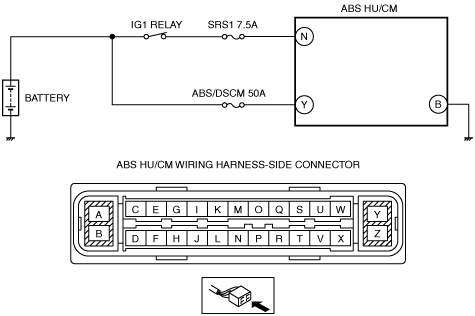|
1
|
INSPECT BATTERY VOLTAGE
• Is the battery positive terminal voltage normal?
|
Yes
|
Inspect for normal connection of the battery terminals.
Go to the next step.
|
|
No
|
Charge or replace the battery, then go to Step 7.
|
|
2
|
INSPECT BATTERY GRAVITY
• Is battery specific gravity as specified?
|
Yes
|
Go to the next step.
|
|
No
|
Replace the battery, then go to Step 7.
|
|
3
|
INSPECT CHARGING SYSTEM
• Are the generator and the drive belt tensions normal?
|
Yes
|
Go to the next step.
|
|
No
|
Replace the generator and/or drive belt if necessary.
Go to Step 7.
|
|
4
|
INSPECT FUSE CONDITION
• Inspect the following fuses.
-
― SRS1 7.5A
― ABS/DSCM 50A
• Is the fuse normal?
|
Yes
|
Go to the next step.
|
|
No
|
Replace the fuse, then go to Step 7.
|
|
5
|
INSPECT ABS HU/CM POWER SUPPLY FOR OPEN CIRCUIT
• Disconnect the ABS HU/CM connectors.
• Switch the ignition ON (engine off).
• Measure the voltage between following connector terminals of the ABS HU/CM (vehicle harness-side) and body ground:
-
― ABS HU/CM: N—Body ground
― ABS HU/CM: Y—Body ground
• Is the voltage 10 V or more?
|
Yes
|
Go to the next step.
|
|
No
|
Refer to the wiring diagram and verify whether or not there is a common connector between following connector terminals of the ABS HU/CM (vehicle harness-side) and positive battery terminal:
― ABS HU/CM: N—Positive battery terminal
― ABS HU/CM: Y—Positive battery terminal
If there is a common connector:
• Determine the malfunctioning part by inspecting the common connector and the terminal for corrosion, damage, or pin disconnection, and the common wiring harness for an open circuit.
• Repair or replace the malfunctioning part.
If there is no common connector:
• Repair or replace the wiring harness which has an open circuit.
Go to Step 7.
|
|
6
|
INSPECT ABS HU/CM GROUND FOR POOR GROUND OR OPEN CIRCUIT
• Switch the ignition to off.
• Measure the resistance between the ABS HU/CM terminal B (vehicle harness-side) and body ground.
• Is the resistance within 0—1 ohm?
|
Yes
|
Go to the next step.
|
|
No
|
• If there is open circuit:
-
― Refer to the wiring diagram and verify whether or not there is a common connector between ABS HU/CM terminal B and the body ground.
If there is a common connector:
-
• Determine the malfunctioning part by inspecting the common connector and the terminal for corrosion, damage, or pin disconnection, and the common wiring harness for an open circuit.
• Repair or replace the malfunctioning part.
If there is no common connector:
-
• Repair or replace the wiring harness which has an open circuit.
― Go to the next step.
• If resistance is not within specification:
-
― Refer to the wiring diagram and verify whether or not there is a common connector between ABS HU/CM terminal B and the body ground.
If there is a common connector:
-
• Determine the malfunctioning part by inspecting the common connector and the terminal for corrosion, damage, or pin disconnection, and the common wiring harness for poor ground.
• Repair or replace the malfunctioning part.
If there is no common connector:
-
• Repair or replace the poor ground part.
― Go to the next step.
|
|
7
|
VERIFY THAT THE SAME DTC IS NOT PRESENT
• Reconnect all disconnected connectors.
• Clear the DTCs from the memory.
• Start the engine and drive the vehicle at 20 km/h {12 mph} or more.
• Are the same DTCs present?
|
Yes
|
Repeat the inspection from Step 1.
|
|
No
|
Go to the next step.
|
|
8
|
VERIFY THAT NO OTHER DTCS ARE PRESENT
• Are any other DTCs output?
|
Yes
|
Go to the applicable DTC inspection.
|
|
No
|
DTC troubleshooting completed.
|
